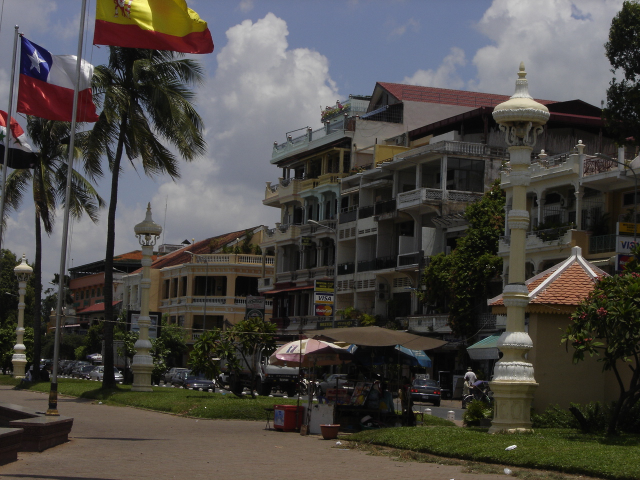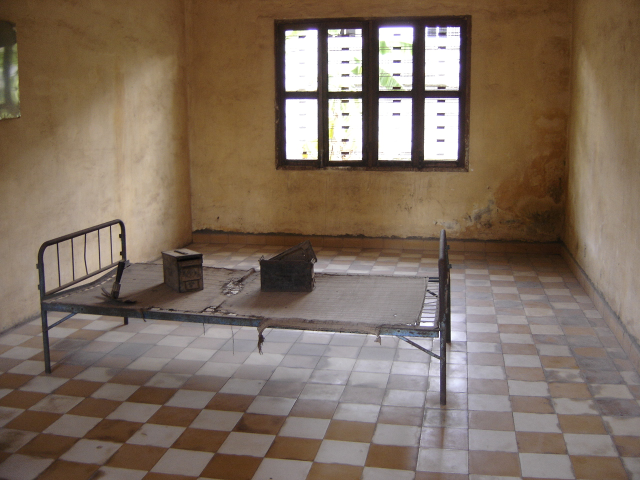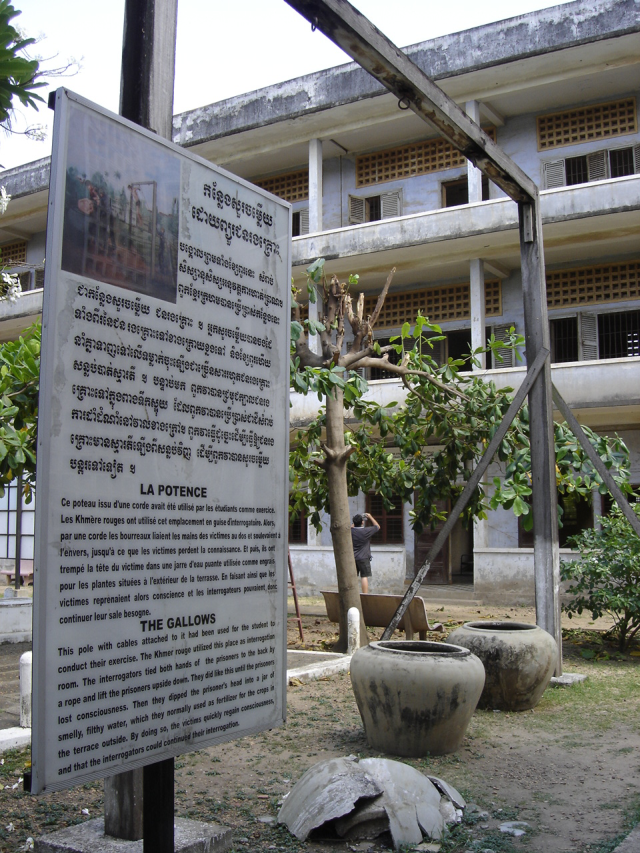The chaotic streets of Cambodia’s capital give a sense of the turbulent history of this land of contradictions and surprises.
As our car nudges its way inch-by-inch through the melee, where motorbikes and luxury cars jostle with heavily laden bullock carts at the point where Charles de Gaulle Boulevard intersects with Mao Tse Tung Road, an emerald Buddha reigns with sublime benevolence from the sanctuary of the gold and gaudy Royal Palace of King Sihamoni.
Phnom Penh is a city that bears its history with a very oriental equanimity; there is little point, says the average Cambodian, in agonizing over things of the past. The future is on the doorstep and they want to grab it with both hands.
There is no doubt that the Cambodians are an industrious people, a mere 30 years after the soldiers of Pol Pot forced the evacuation of the city and marched the entire population into what is now known as the Killing Fields of Cambodia, Phnom Penh is as bustling as any other Asian metropolis, albeit as contradictory.
We are searching for Tuol Seng, formerly the Khmer Rouge S-21 prison, now a genocide museum, where over 12000 people were detained, tortured and eventually killed by the Pol Pot regime. Even the name connotes a terrible meaning in itself. Literally, the ‘poisonous hill where those who bear or supply guilt,’ Tuol Sleng Prison (The first picture below is of an interrogation room) was established in 1976 specifically designed to detain and exterminate anti-Angkar elements.
Previously a high school, the buildings were shut of from the world with sheets of corrugated iron reinforced with electrified barbed wire. The classrooms were converted into prison cells and torture chambers. Victims were taken from all walks of life and many different nationalities (New Zealanders included) were also interred there before being exterminated. Only seven people are known to have survived Tuol Seng.
The Khmer Rouge, with a weird attention to the imperialist bureaucracy they so despised, took photos and details of all the detainees. Today their faces stare back mutely in row upon row of photographic evidence of a world gone mad. Every face demands a witness but one stands out above all, a woman with her eyes firmly closed against her impending doom.
The Khmer Rouge managed to exterminate over two million of the citizens of Cambodia, turning the entire country into a concentration camp where everyone was forced to participate in the agricultural reform that was designed to liberate Cambodia or die.
The regulations still posted outside the gallows (the second picture below) in Tuol Seng give instructions for behavior under torture.
“Do not try to hide the facts by making pretext of this and that. You are strictly prohibited to contest me,” advises the caution. “Do not tell me about either your immoralities or the revolution”, and “While you are getting lashes or electrification, you must not cry at all.”
I declined to visit the Killing Fields further out of the city, where the blood and bones of hundreds of thousands more victims of Pol Pot fertilized the rice paddies now brown and barren in the pre monsoon heat. Instead we made our way to the Killing Fields of modern day Cambodia and one where the same rules for behavior under torture still apply.
Svay Pak is easy enough to find, directions to it can be found on the Internet. A rough dusty street, no longer than 100 metres jammed with perhaps 20 or more brothels is the latest gathering place for pedophiles from abroad. Accents from all over the world can be heard as men take a beer after their activities in ramshackle buildings made chillingly from the same kind of cheap air bricks that were used in cells in Tuol Sleng.
This South East Asian hotspot is attracting the latest threat to the new generation of Cambodians; it has become both a destination and a transit point for sex tourists and pedophiles seeking immoralities that are literally robbing Cambodia of its young and vulnerable, who also must not cry at all.
This is where life is worth no more than a three American dollars, where foreign men refer to child sex slaves as ‘players’ and where even police, with an average wage of $US25 a month, can be bought off to avoid prosecution. Despite the recent law changes in Cambodia which make this kind of traffic illegal, often raids to the red light districts are advertised well in advance giving the brothel owners time to flee across the border to Vietnam with their child slaves or move them into other cities such as Siem Reap, the service town for the Angkor Wat temples.
My driver, a young Cambodian man in his mid 20s is nervous, almost speechless with embarrassment. Suddenly aware that I am in a red light district with a boy half my age, I agree with him. We have seen enough. But unlike the woman at Tuol Sleng whose defiant eyes remain sealed shut, once your eyes are open to this modern day genocide, what to do?
A UNICEF survey concluded that unscrupulous brothel owners In Cambodia alone hold almost 20000 children captive, which is one-third of the total amount of sex workers in the country.
Child Wise (ECPAT Australia) is conducting Child Safe Organisation Training to local NGOs and INGOs focusing on how to set up child protection policy and procedures within the organization. They also advertise a website for reporting child sex crimes.
But New Zealand falls slightly behind the mark in warning travelers of this breech of human rights.
ECPAT is a global network dedicated to combating child prostitution, abuses and trafficking. Spokesperson for ECPAT New Zealand Jane Foster says, “When we approached New Zealand NZ Travel and Tourism operators in 2005 and 2006, to promote our website for reporting child sex crimes, there was a poor response.”
“They did, however support our lobbying the Ministry of Foreign Affairs & Trade to include a page on child sex crimes on its travel advisory website in March.”
“To the best of our knowledge the only travel and tourism operator in New Zealand that supports the World Tourism Organisation Code of Conduct regarding children is the ACCOR Hotel group,” she continues. “Currently, New Zealand is not a member of the World Tourism Organisation so there is little knowledge of the Code here. ACCOR is a French operator and their compliance with the code stems from the parent company.”
Driving out of Phnom Penh towards Siem Reap, the scorched rice paddies await the first downpour of the monsoon from clouds that billow overhead; occasionally the sky is raked with fingers of lightening. Lining the roadside are ponds of farmed lotus, their pink flowers so favoured by Buddha. In a matter of weeks, these same fields will be as vibrantly as green with new life as the emerald Buddha at the Royal Palace.
I say a silent prayer that the children of modern day Cambodia can rise up also untouched through the muddy Killing Fields like the eternal bloom.
Dianne Sharma-Winter is a freelance writer living between India and New Zealand. She writes on travel, culture and humour using India as her muse.









Moving! My visit to the killing fields was on a Christmas morning in 2006. It was the same soul-searing experience as when I visited the museum in Hiroshima.
Despite the ever-smiling faces of the friendly Cambodians, those we spoke to said fear always lurks just below the surface – fear that the horrors of the recent past might resurface. Tellingly, when we were dining on the boulevard, suddenly police arrived and forcibly carted away the homeless and the beggars in vans, caning those who resisted, as they were sullying the image for the foreign tourists. Some children hid and watched their parents being taken away. It left us with a taste of what those in power are capable of.
Thanks for your comments Rani, Cambodia is a very enigmatic country, just about to head back there for another peek at the place…lovely people though
Charles de Gaulle, Buddha and Mao – a heady brew indeed! It’s quite shocking what goes on in Cambodia concerning pedophiles, sex slavery, etc. I visited in 1995 and Phnom Penh felt like a frontier town – a palpable edginess. Cambodia, Vietnam and Laos were always in the news when I was a teenager. Various sources have put the number killed by KR between 75,000 and 300,000 (including US State Dept intelligence). But whether it’s 75,000 or two million, a hell of a lot were murdered throughout the 1970s in Cambodia by many guilty parties.
Its difficult to understand how such things can be ignored in the rush toward the future. Those who ignore the mistakes of history are doomed to repeat it etc but for me the interesting point was the mindset of the people. Things too terrible to tell but the wounds are very deep
Poverty and the lack of law enforcement both contribute the prevalence of sex tourism in Cambodia. I would like to applaud international aid organizations like World Vision for helping to combat sex slavery in the country.